Seawanhaka Home
Where Is
Ships Log
Itinerary
About the Ship
Meet the Skipper
Crew Page
Photo Album
Contact Us
|
|
Viti Levu Trip - October 2004
While Captain Bill stayed behind with Seawanhaka to manage the haul-out process, I (Elizabeth) took an 8-day trip around the island of Viti Levu here in Fiji. Viti Levu is the largest of the Fiji Islands and is home to the largest cities in the country, plus mountains, rivers, rainforests, beaches and farmland. The mountainous interior is more difficult to travel around so I took a loop around the island clockwise, sticking to the coasts for the most part. Viti Levu, which means "Big Fiji", is a beautiful island with a huge variety of landscapes and sights. I heard that you can actually circle the whole island by bus in one (very long) day but I decided to take my time and spend 8 days making the loop.
| Day 1 - I left Suva on a Tuesday morning, leaving behind Seawanhaka and the Fiji Shipyard that had become a sort of home over the last several days. We have been staying on Seawanhaka during her big haul-out. I took the express bus from Suva along the south coast of Viti Levu. As I traveled west from Suva, the weather became less rainy and the skies became clearer. On the left side of the bus, I could see the coral reefs, beaches, and offshore islands of Kandavu and Beqa. To our right, the green mountains of Viti Levu's interior towered over us. We passed through villages large and small, stopping for a short break in Novua. The Fijian people are so friendly and helpful that I never worry about finding the right bus or telling the bus when to stop to let me off...there's usually someone around to help me before I can even ask. The Fijians are known for their friendliness and I must say this is one time when the stereotype fits the people! I got to my first stop, The Beachhouse, safely and got some sunny beach time in immediately. The Beachhouse is a "backpacker's resort" on a gorgeous little beach in the middle of a region known as the Coral Coast. |
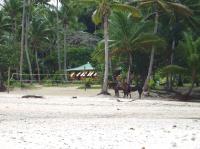
View of The Beachhouse from the beach.

Nightly volleyball tournament. |
| Day 2 - Morning at the Beachhouse proved to be full of activities. As people dragged themselves out of their cottages (bures) and tents, our Fijian hosts gave us a whole array of activities to choose from including diving and snorkeling trips, a jungle trek, a village visit, a trip to Suva, massages, horseback riding, etc. It was soon evident that this was a place for activity. I chose the Jungle Trek, which turned out to be a GREAT trip. Our Fijian guide took us to a neighboring village and then on a hike in the nearby jungle, pointing out all the native plants and animals we encountered. I learned to identify kava, taro, kasava, and noni plants as well as mango, papaya and breadfruit trees. There were lots of other plants (with Fijian names only) that are used by the people as home remedies for various ailments. The pinnacle of the trek was "Shower Falls", a cool freshwater waterfall where we swam and played in the water. It was a great trek. We returned to the Beachhouse for tea and the nightly volleyball tournament. I think I played more volleyball in my 3 days at the Beachhouse than I have in my life! It was great fun. |
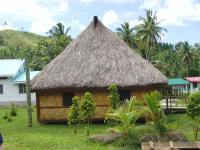
A traditional Fijian bure (house) in the village of our guide.
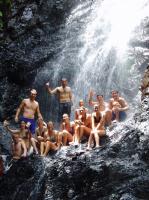
Cooling off at Shower Falls, after 2 hours of jungle trekking. |
| Day 3 - Today I spent a VERY lazy day on the beach. I began to think I might get stalled out at The Beachhouse and never make it around the island so I made plans to leave in the morning to continue around to the west side of the island. |
| Day 4 - After breakfast I said goodbye to all of my new traveling friends and caught a bus to the Sigatoka Sand Dunes. Sigatoka is known as the "salad bowl" of Fiji because of all the beautiful fruits and vegetables that are grown in this fertile region around the Sigatoka River. Where the river meets the ocean there is no reef and natual sand dunes have formed. I hiked around the dunes with 2 Swedish and 2 Canadian friends from the Beachhouse and a trusty guide dog named Ranger. The dunes were spectacular and the ocean crashed into them with such force...it was a magical place. We headed back out to the main road and caught a ride into Nadi. Nadi (pronounced Nan-di) is home to Fiji's only international airport and for most people, this is their first view of Fiji. That's too bad because it's also the pit of the earth...crappy souvenir stores, tourist traps, and lots of people trying to sell you t-shirts or tours. We had a fun night in Nadi because we stayed at a fun hostel but after one night in Nadi, I was ready to strike out on my own and keep moving along. |
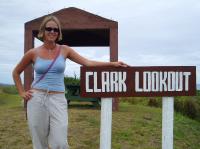
Atop Clark Lookout at the Sigatoka Sand Dunes
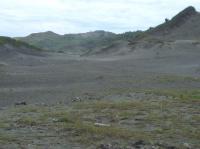
A view across the dunes.
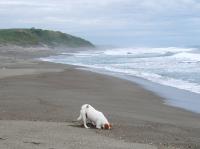
Ranger the dog has probably hiked the trail to the dunes more than anyone else in the world. |
| Day 5 - After a bit of shopping and wandering around Nadi, I was quite ready to head north to Lautoka. This western part of the country is known for its sugar cane production. At the center of this huge industry is the Fiji Sugar Mill at Lautoka. As my bus drove along the "highway" toward Lautoka, I saw waving fields of green sugar cane stretching out into the distant hills. There were cute little cane cars running on narrow railroad tracks everywhere, as workers moved the bundles of cane from the fields to the mill. This region is culturally different from the rest of Fiji - about 4 generations ago, the British imported Indian laborers to work the cane fields. Many of the Indians stayed in Fiji and today Fiji is almost a 50-50 blend of native Fijians and Indo-Fijians. In the western and northern parts of the country, the Indo-Fijian population is very significant so I heard more Hindi spoken than Fijian. Also, there were tasty curry houses, Indian clothing shops and Hindu temples all around. I spent one night in Lautoka, Fiji's second largest city, where I had a nice time except my roommate for the night was an overzealous Jehovah's Witness who spent her energy trying to convert me. I politely refused and hopped a mini-bus to the north side of the island in the morning. |
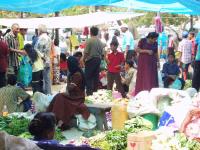
The bustling marketplace at Nadi.
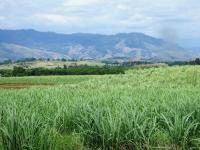
The sugar cane fields of western Viti Levu.

Waterfront at Lautoka.
|
Day 6 - I traveled from Lautoka along the north side of Viti Levu, through cane fields and mountains and picturesque lagoons. My destination was a small island called Nananu-i-ra, which is just a 10-minute boatride off the northeast side of Viti Levu. This coast of the big island is less touristy than most of Fiji. Although it's very sunny and drier, there are really only villages and farmland rather than resorts. The exception is Nananu-i-ra, a small sandy island lined with palm trees and white sandy beaches which is home to 4 small resorts. I left the bus at Ellington Warf and caught a boat ride out to Betham's Beach Cottages on Nananu-i-ra. This resort was gorgeous, with a soft, warm beach only steps away from my beach cottage. I spent a pleasant afternoon meeting my new roommates (who were great fun) and lounging on the beach. At sunset, we all trekked up to a nearby lookout spot which gave us a great view of our island and the distant hills of Viti Levu, stretching out to the south and west in the setting sunlight. |
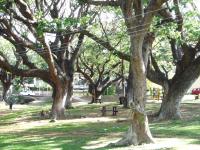
Big trees in the park - Lautoka had lots of parks and a botanical garden.
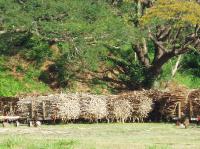
Bundles of sugar cane on carts headed for the sugar mill in Lautoka
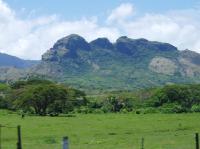
Mountain views along the north side of Viti Levu.
|
| Day 7 - Someone I had met warned me that if I went to Nananu-i-ra, I should be prepared to do absolutely NOTHING. This proved to be true but I had a good time working on my tan, snorkeling around the reefs and taking a beachwalk around half the island. In the evenings, I learned a new card game from 2 very fun Irish girls and helped host a kava night at our cottage. Kava, or yaqona as it's called in Fiji, is a slightly narcotic drink that many South Pacific Islanders drink like crazy. It's derived from the roots of the kava plant, which is related to the black pepper plant. Fijians, like Samoans and Tongans, can sit around and drink kava for hours and they even use it in their traditional cultural ceremonies. Kava tastes a bit like dishwater and feels a lot like going to the dentist...it makes your tongue and teeth numb for a while. I can't quite figure out the kava craze but when you visit a village here in Fiji, you must present a gift of kava roots or powder to the local chief. It's not such a tradition if you are staying in resorts but when we sail to a new island or village, we will take kava gifts for our hosts. |
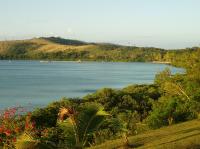
Looking out over Nananu-i-ra island.
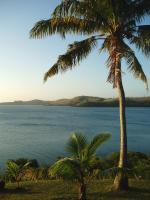
A view from the "sunset spot" on Nananu-i-ra.
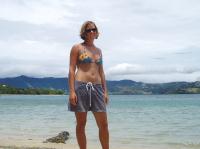
Elizabeth on the beach with Viti Levu in the background. |
| Day 8 - By this day, my mini-vacation is coming to an end and I'm really excited to get back to the familiarity of Suva. I'm also really anxious to see the progress on Seawanhaka during my week away. The road between Ellington Warf and Suva is under construction...and by that I mean they are building the road for about a 50 mile stretch through the hills. There has only been an unsealed dirt road in this area but it has frequently been washed away by heavy rains. The large and seemingly uncoordinated project made my bus ride a dirty, bumpy 5-hour trip. We traveled through small villages along the Rewa River. At a few points I got a glimpse of the tiny, one-lane, wooden plank bridges ahead and wondered how in the world the bus would make it over without slipping off. It was quite an adventure. The scenery was beautiful as I journeyed through the last leg and returned to the lush green forested hills of eastern Viti Levu. The bus ride made me even happier to see Suva! I was greeted warmly and pleasantly surprised by the progress the guys had made on Seawanhaka. All in all, a great trip around a beautiful island. |
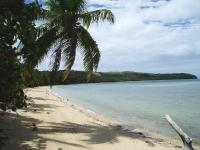
3/4 mile beach, on the east side of Nananu-i-ra.
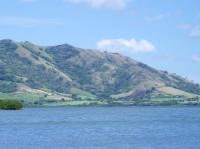
The hills of Viti Levu from Ellington Warf.

Scary road construction project along the Rewa river. |
 Go back to Fiji photos. Go back to Fiji photos.
|
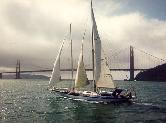 Schooner Seawanhaka
Schooner Seawanhaka![]()